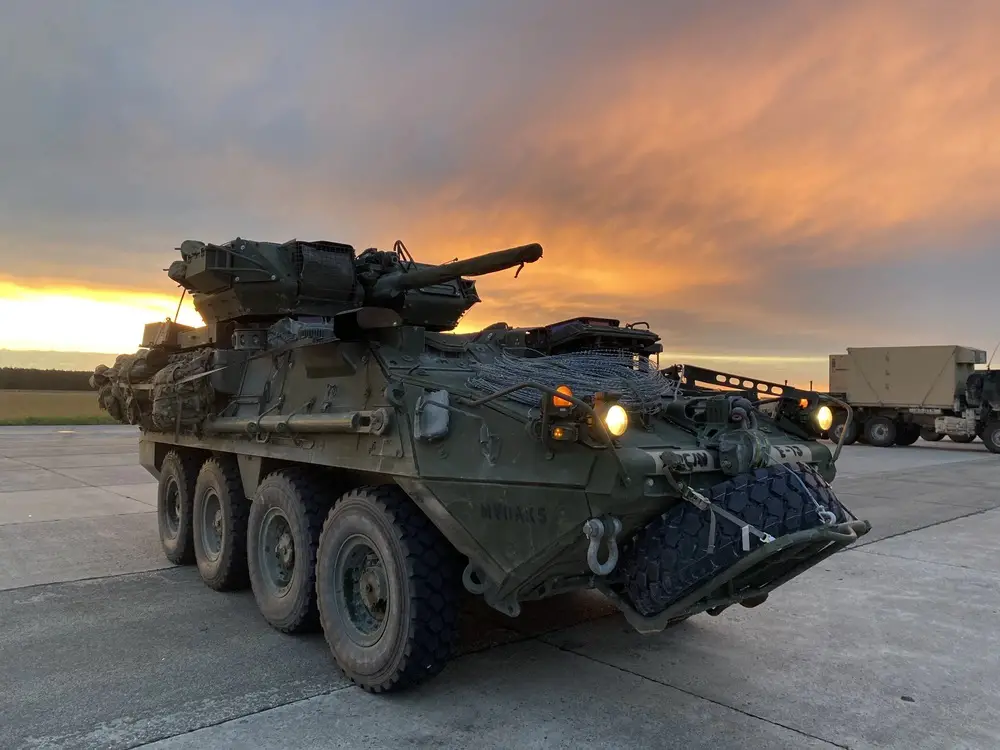The U.S. Army rolled out its first upgunned Stryker vehicle, nicknamed Dragoon. The armored eight-wheel-drive troop transport, built by General Dynamics and normally armed with no more than a 0.50 calibre (12.7 millimeter) machinegun in an unprotected mount, has been rebuilt with an armored turret containing a 30 mm quickfiring cannon. “Dragoon” is an appropriate term for Stryker forces. More mobile and better protected than foot troops, they’re still nowhere near as tough as M1 tank or the M2 Bradley troop carrier. Like the original dragoons in the black powder and musket days, Stryker units are a hybrid that ride to the battle but then dismount to fight on foot in battle. That’s enough firepower, the Army computes, to dispose of other lightly armored vehicles like the Russian BMP troop carrier.

If the Russians invade the Baltics, the M1296 Stryker Infantry Carrier Dragoon can’t stop their heavy tanks, but it can thin out their scout vehicles and transports, allowing American M1 tanks to focus their 120 mm firepower on the heaviest targets. The program also kept as much commonality as possible with the Stryker platform, including the fire-control system and the suspension from the double-V hull version of the vehicle. This upgraded Stryker has a remotely-operated 30mm cannon weapon system, unmanned turret, a new, fully-integrated commander’s station; and upgraded driveline component and hull modifications, according to information from Program Executive Office-Ground Combat Systems. It was created to fill a capability gap in the European theater that puts Soldiers at unacceptable risk. Since publication of the urgent operational needs statement in 2015, this new system has undergone a rapid acquisitions process in order to provide 2CR with a needed capability.

Units equipped with the M1296 Stryker Infantry Carrier Dragoon will provide Combatant Commanders a medium-weight force capable of rapid strategic and operational mobility to disrupt or destroy enemy military forces, to control land areas including populations and resources, and to conduct combat operations to protect U.S. national interests. The direct fire weapon system upgrade is intended to provide effective mounted and dismounted combined arms and freedom of maneuver during combat operations. The Stryker 30 mm ICVD program integrates an unmanned turret with a 30 mm autocannon onto a flat-bottom Stryker Infantry Carrier Vehicle. Initiated via a limited ONS, the ICVD is not a program of record. The 30 mm autocannon is intended to employ High Explosive Incendiary – Tracer and Armor Piercing Fin Stabilized Discarding Sabot – Tracer rounds. The crew is intended to be able to reload these munitions under armor. The ICVD features a coaxial machine gun and smoke grenades on the turret.

This variant increases lethality and provides 2CR the additional assets needed to defend the NATO Alliance against any adversaries if called to do so. More ICVDs are scheduled to arrive over the next month. Dragoons will be equipped with the platform to conduct an End User Test and Evaluation (EUTE) at Hohenfels Training Area in April 2018. Following this, fielding will begin with 1st Squadron, 2CR receiving the ICVD at Bemowo Piskie Training Area during their NATO Enhanced Forward Presence rotation. As the US military reoriented anxiously to Europe and the heavily armored Russian army, however, 12.7 mm looked awfully small. With this prototype Dragoon and its 30 mm cannon, the Army’s well on its way to fixing that. With the right airbursting ammunition, the 30 mm weapon might even take out low-flying aircraft. In parallel, to defeat Russian drones, the Army is experimenting with a low-powered anti-aircraft laser, also mounted on a Stryker.
















